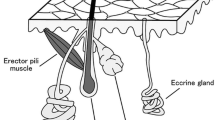Summary
In a warm environment at ambient temperatures between 25° and 38°C (relative humidity 50%–60%) the relationship between sympathetic activity in cutaneous nerves (SSA) and pulses of sweat expulsion was investigated in five young male subjects. The SSA was recorded from the peroneal nerve using a microelectrode. Sweat expulsion was identified on the sweat rate records obtained from skin areas on the dorsal side of the foot, for spontaneous sweating and drug-induced sweating, using capacitance hygrometry. Sweat expulsion was always preceded by bursts of SSA with latencies of 2.4–3.0 s. This temporal relationship between bursts of SSA and sweat expulsion was noted not only in various degrees of thermal sweating but also in the sweating evoked by arousal stimuli, or by painful electric stimulation. The amplitude of the sudomotor burst was linearly related to the maximal rate of increase of the corresponding sweat expulsion, the amplitude of the expulsion and the integrated amount of sweat produced for the duration of the expulsion. The results provide direct evidence that sweat expulsion reflects directly centrally-derived sudomotor activity.
Similar content being viewed by others
References
Adams T, Vaughan JA (1965) Human eccrine sweat gland activity and palmar electrical skin resistance. J Appl Physiol 20:980–983
Bini G, Hagbarth K-E, Hynninen P, Wallin BG (1980a) Thermoregulatory and rhythm-generating mechanisms governing the sudomotor and vasoconstrictor outflow in human cutaneous nerves. J Physiol (Lond) 306:537–552
Bini G, Hagbarth K-E, Hynninen P, Wallin BG (1980b) Regional similarities and differences in thermoregulatory vaso- and sudomotor tone. J Physiol (Lond) 306:553–565
Blumberg H, Wallin BG (1987) Direct evidence of neurally mediated vasodilatation in hairy skin of the human foot. J Physiol (Lond) 382:105–121
Delius W, Hagbarth K-E, Hongell A, Wallin BG (1972) Manoeuvres affecting sympathetic outflow in human skin nerves. Acta Physiol scand 84:177–186
Edelberg R (1964a) Independence of galvanic skin response amplitude and sweat production. J Invest Dermatol 42:443–448
Edelberg R (1964b) Effect of vasoconstriction on galvanic skin response amplitude. J Appl Physiol 19:427–430
Fagius J, Wallin BG (1980) Sympathetic reflex latencies and conduction velocities in normal man. J Neuro Sci 47:433–448
Fox RH, Hilton SM (1958) Bradykinin formation in human skin as a factor in heat vasodilatation. J Physiol (Lond) 142:219–232
Hagbarth K-E, Hallin RG, Hongell A, Torebjörk HE, Wallin BG (1972) General characteristics of sympathetic activity in human skin nerves. Acta Physiol Scand 84:164–176
Hallin RG, Torebjörk HE (1970) Afferent and efferent C units recorded from human skin nerves in situ. Acta Soc Med Ups 75:277–281
Iwase S, Mano T, Sugenoya J, Saito M, Hakusui S (1988) Relationship among skin sympathetic nerve activity, sweating, and skin blood flow. Environ Med 32:55–67
Jänig W, Kümmel H (1977) Functional discrimination of postganglionic neurones to the cat's hindpaw with respect to the skin potentials recorded from the hairless skin. Pflügers Arch 371:217–225
Lidberg L, Wallin BG (1981) Sympathetic skin nerve discharges in relation to amplitude of skin resistance responses. Psychophysiology 18:268–270
Lindh B, Haegerstrand A, Lundberg JM, Hökfelt T, Fahrenkrug J, Cuello AC, Graffi J, Massoulié J (1988) Substance P-, VIP- and CGRP-like immunoreactivities coexist in a population of cholinergic postganglionic sympathetic nerves innervating sweat glands in the cat. Acta Physiol Scand 134:569–570
Lundberg JM, Änggård A, Fahrenkrug J, Hökfelt T, Mutt V (1980) Vasoactive intestinal polypeptide in cholinergic neurons of exocrine glands: functional significance of coexisting transmitters for vasodilation and secretion. Proc Natl Acad Sci USA 77:1651–1655
Nakayama T, Takagi K (1959) Minute pattern of human perspiration observed by a continuously recording method. Jpn J Physiol 9:359–364
Ogawa T, Bullard RW (1972) Characteristics of subthreshold sudomotor neural impulses. J Appl Physiol 33:300–305
Ogawa T, Terada E, Kobayashi M, Takagi K (1965) Variations of the electric conductivity of the skin in relation to sweating. Jpn J Physiol 15:296–309
Snedecor GW, Cochran WG (1967) Statistical Methods, 6th edn. Iowa State University Press, Ames, Iowa
Sugenoya J, Ogawa T (1985) Characteristics of central sudomotor mechanism estimated by frequency of sweat expulsions. Jpn J Physiol 35:783–794
Tainio H, Vaalasti A, Rechardt L (1987) The distribution of substance P-, CGRP-, galanin- and ANP-like immunoreactive nerves in human sweat glands. Histochem J 19:375–380
Wilcott RC (1962) Palmar skin sweating vs. palmar skin resistance and skin potential. J Comp Physiol Psychol 55:327–331
Author information
Authors and Affiliations
Rights and permissions
About this article
Cite this article
Sugenoya, J., Iwase, S., Mano, T. et al. Identification of sudomotor activity in cutaneous sympathetic nerves using sweat expulsion as the effector response. Eur J Appl Physiol 61, 302–308 (1990). https://doi.org/10.1007/BF00357617
Accepted:
Issue Date:
DOI: https://doi.org/10.1007/BF00357617




